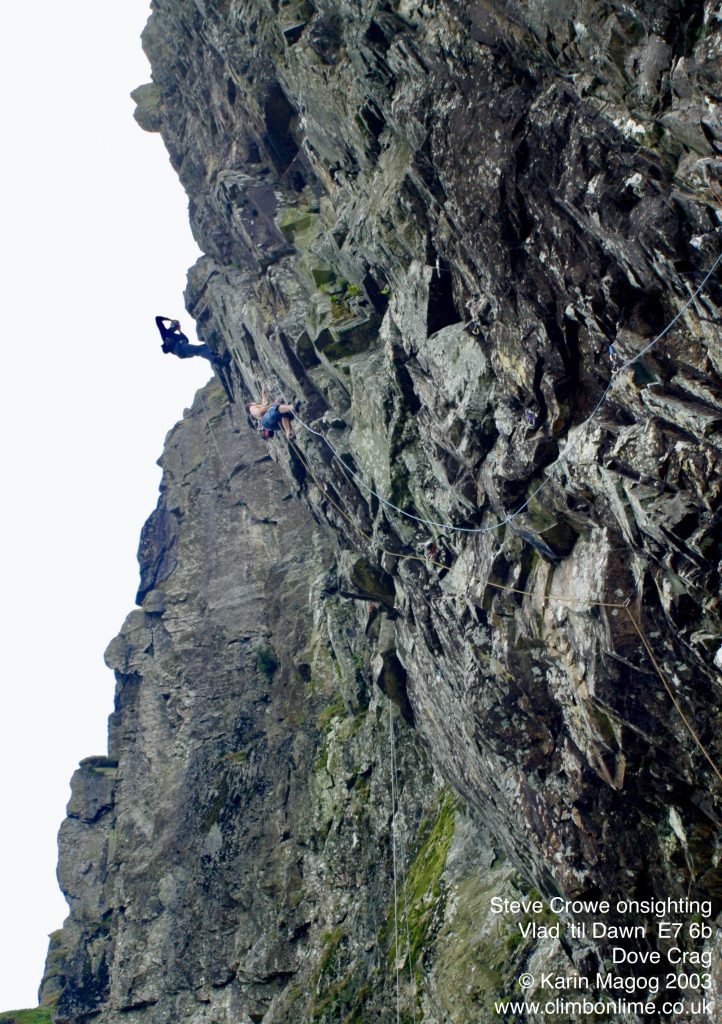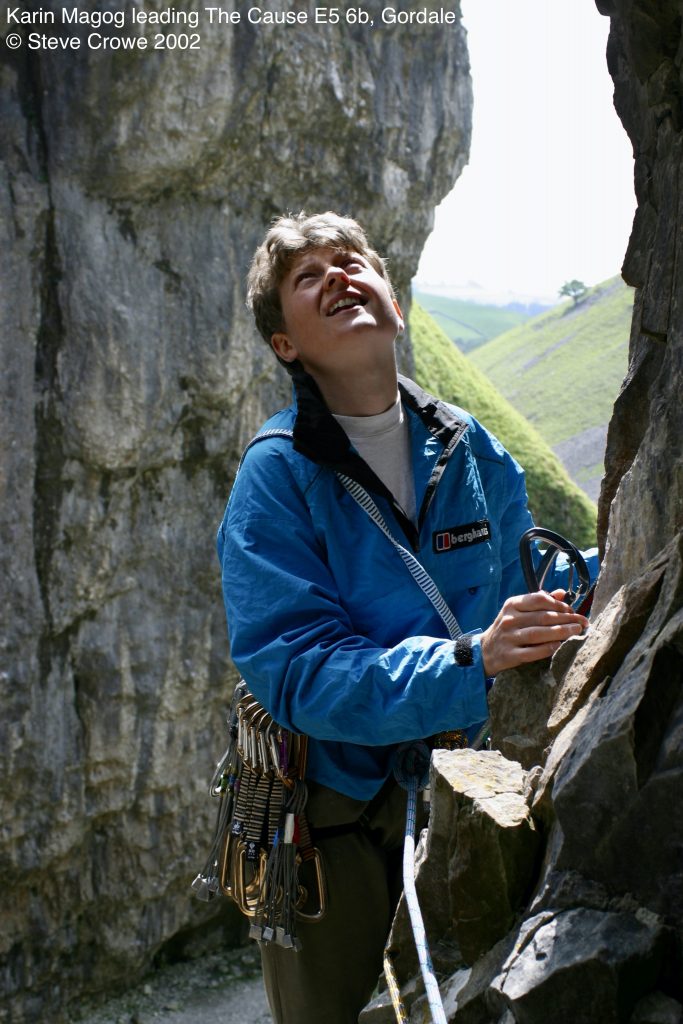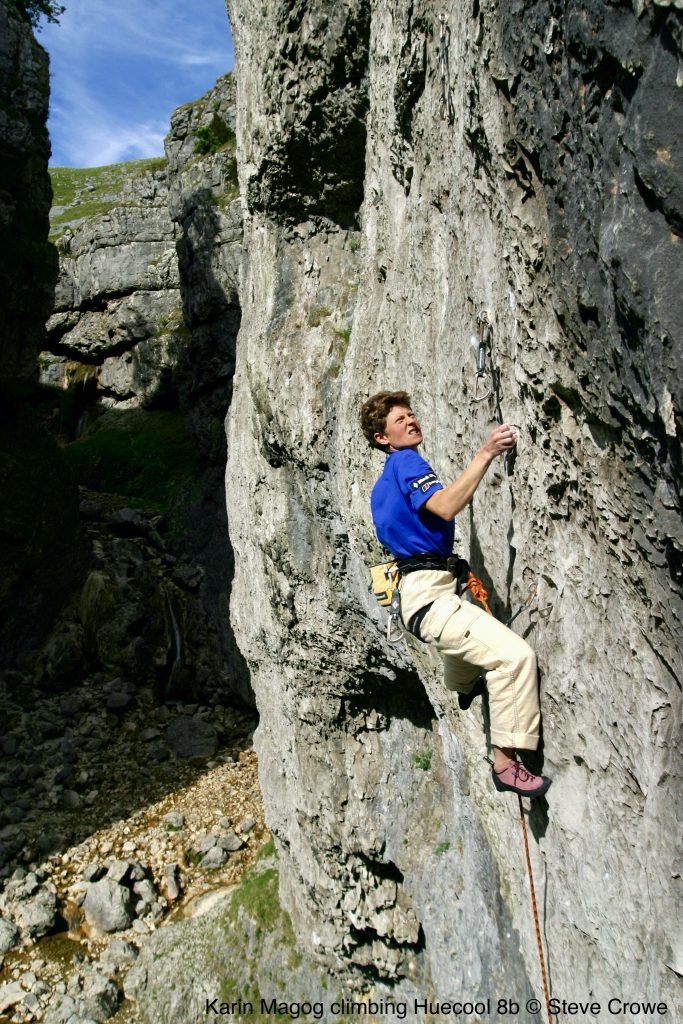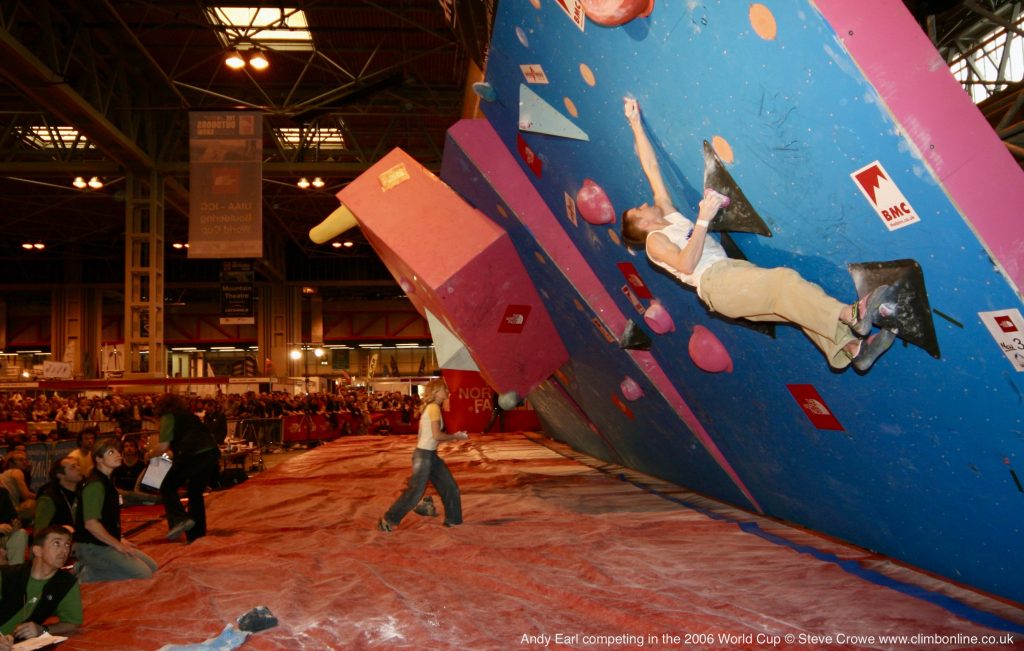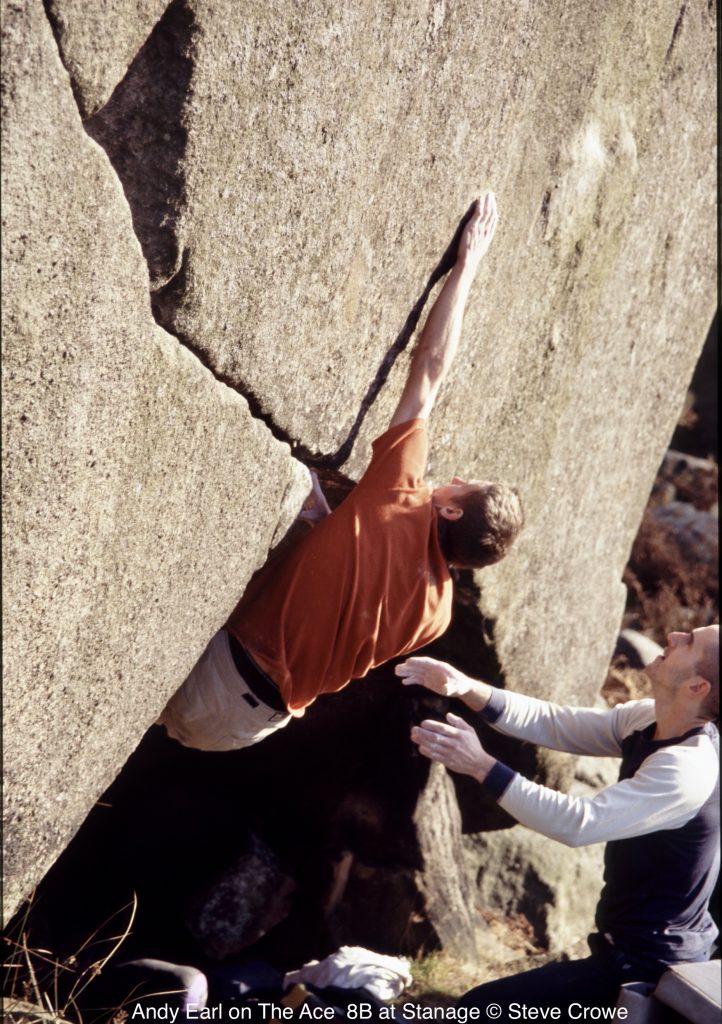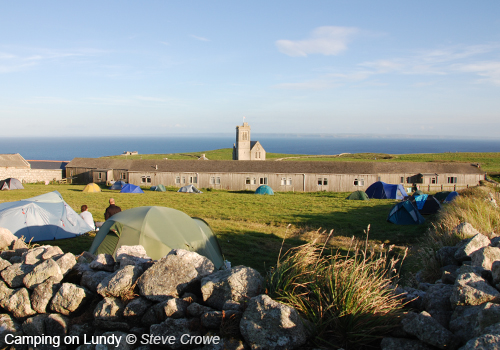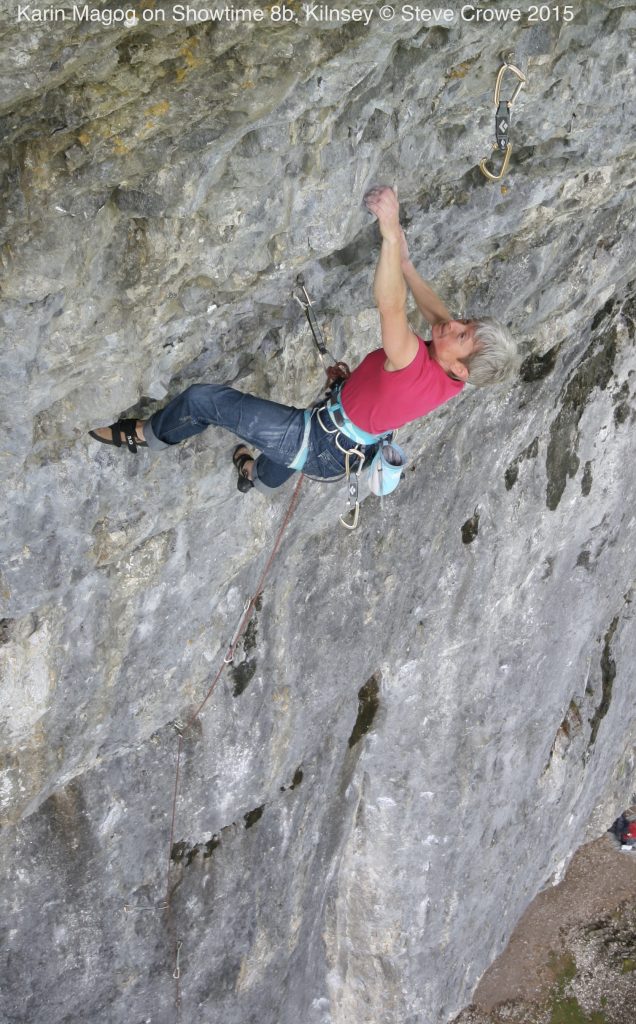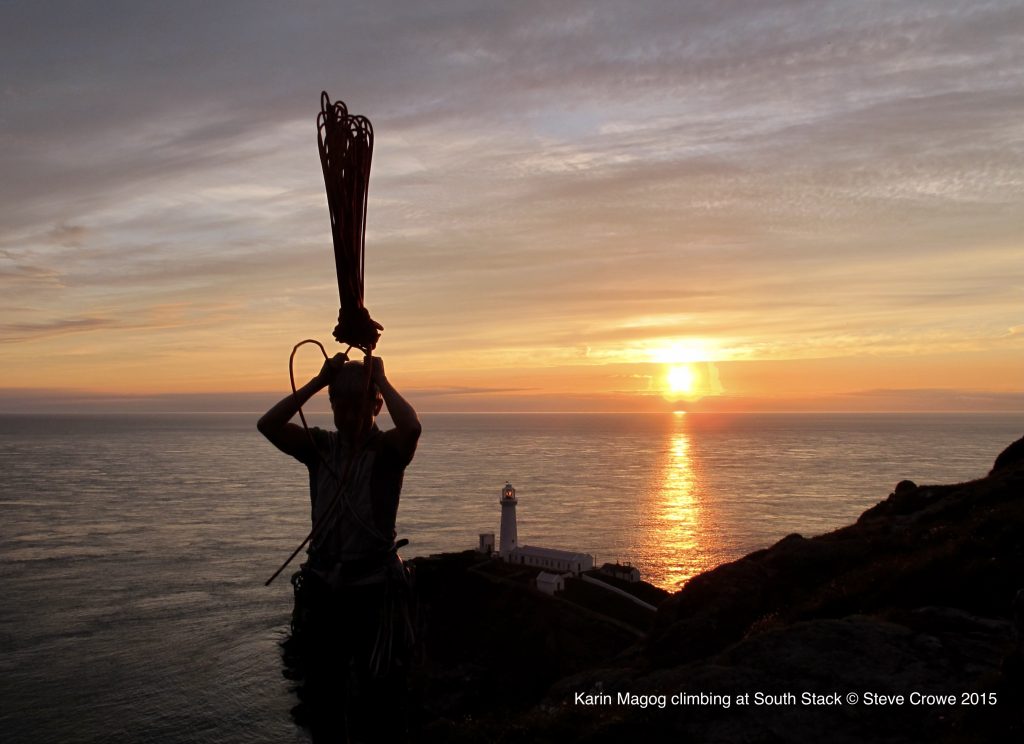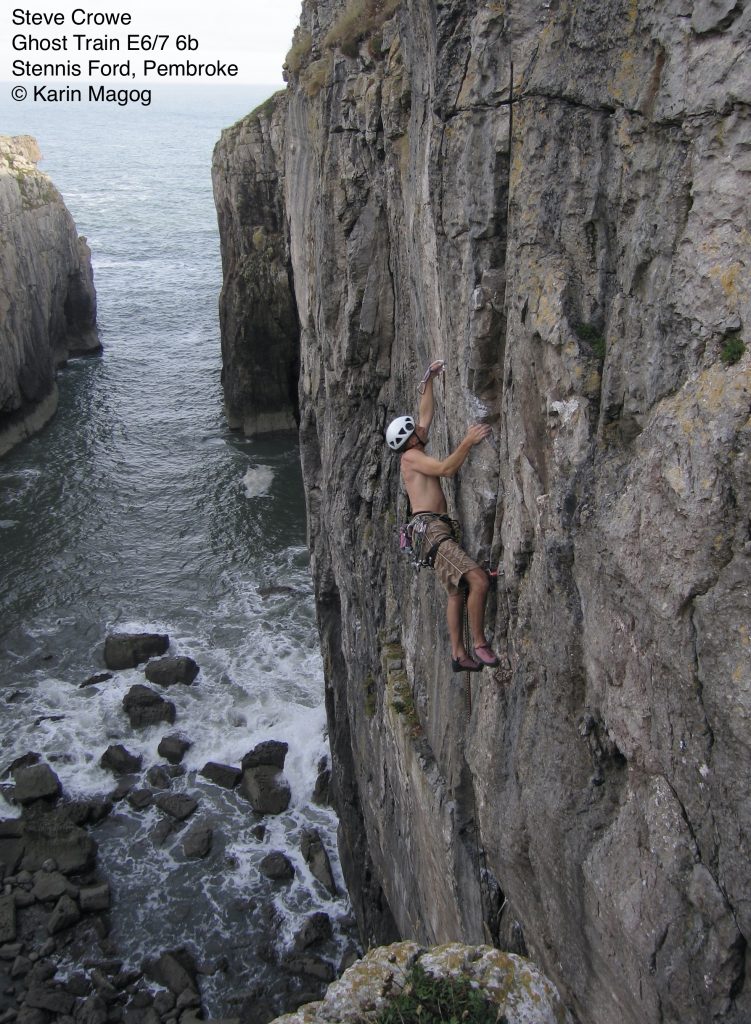
An Introduction to Rock Climbing in the Western Cape of South Africa by Karin Magog
South Africa, like the States, has many different climbing areas so where do you start? Well you couldn’t go wrong with a trip to the Western Cape. Cape Town itself is one of the top cities in the world, and a very popular venue in it’s own right. It’s in a fantastic situation with Table Mountain and the Twelve Apostles curving through the city and surrounded by fantastic beaches. Accommodation is plentiful, with several cheap Back Packers and it’s generally very cheap to eat out. There’s plenty of climbing around Cape Town but it’s worth exploring inland as well, with several good climbing venues along the N1 to the east, and, to the north, the Cederberg Mountains in particular offer some fantastic climbing. The majority of the crags are hard sandstone but all have their own unique character and are very different to the sandstone here in Britain.
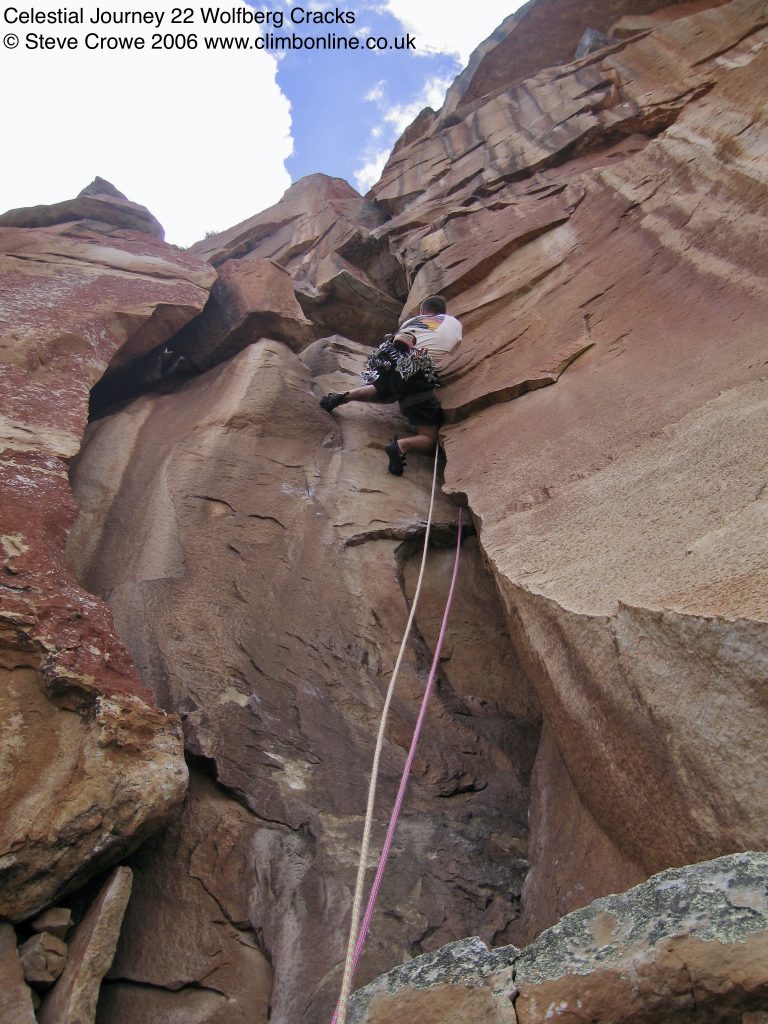
TABLE MOUNTAIN
You can’t miss this as it is literally in the middle of Cape Town. A steep 1.5 hours walk leads up to the ledges (there is a cable car but it’s not the done thing!), from where you have a choice of climbing in the sun or shade, with Africa Ledge on the left getting the morning sun and Fountain Ledge to the right the afternoon. It is possible to climb here all year round depending on the weather. Even when the ‘south easter’ is blowing the tablecloth over the mountain, Fountain Ledge is usually the most sheltered spot to climb on the Peninsula. The rock is very hard, compact sandstone with regular breaks (or rails as the locals call them), which take good gear – plenty of cams are essential. It also forms some fantastic juggy chickenheads. The crag offers some great multi-pitch trad routes of all grades and the views are spectacular. Just some of the routes to look out for are: – Africa Crag (12), Atlantic Crag (18), Oddshouters Outing (22), Africa Arête (25), No Longer at Ease (25) and African Lunch (23), all on the African Ledge, and Arms Race (23), The Dream (21), Touch and Go (21), Triple Indirect into Magnetic Wall (20), Captain Hook (23), Jacob’s Ladder (16) (which traverses out on monster holds above a massive roof – not for weak-kneed seconds!) and Roulette (20/21), on the Fountain Ledge. The crag also offers several testpieces including One Flew over the Cuckoo’s Nest (30), Jeopardy (29), Double Jeopardy (30) (by Britain’s Dave Birkett) and the recent Mary Poppins and her Umbrella (32). For an interesting route to the main crag try linking Frasers Variation (on the lower buttresses) into Arrow Final, this gives good quality climbing at a low grade (V Diff) and breaks up the tedious walk-in. The lower buttresses are worth a visit if time is short, check out the classic Bombay Duck (17). As well as the climbing Table Mountain has much more to offer. Combined with the Cape Peninsula it is one of the 6 floral kingdoms of the world with more species diversity than the whole of the British Isles. The mountain also offers many classic walks and scrambles.
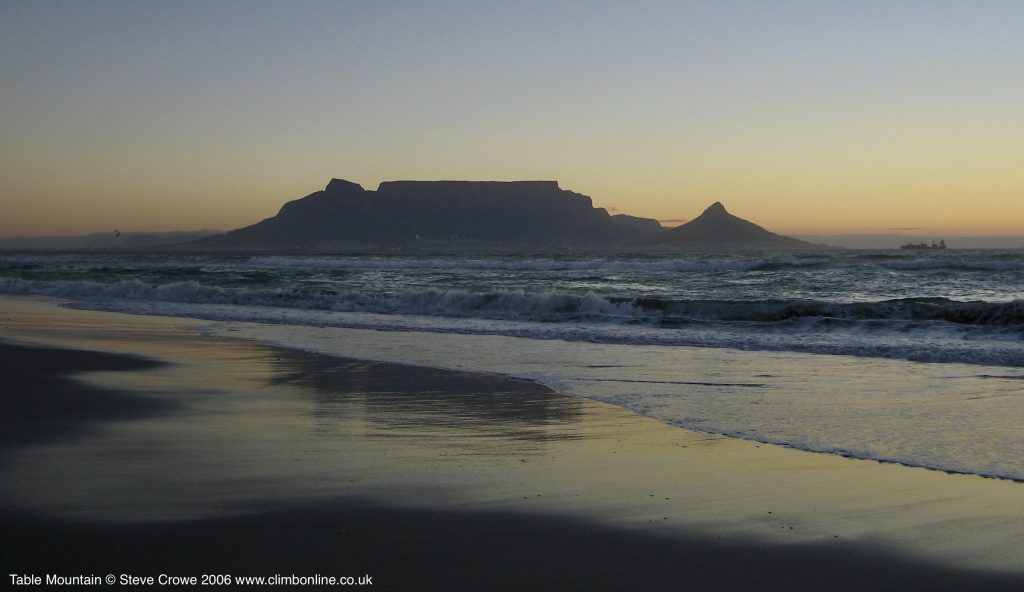
SILVERMINE and THE MINE
Both are good sports climbing venues near Muizenburg, about 20 mins drive from Cape Town. They offer a good range of grades with the climbing being vertical to overhanging and are climbable year round. Silvermine has four bolted crags (Main Crag, Blaze of Glory, Fawlty Towers and Lower Silvermine) with the Main Crag offering routes up to 30m on vertical walls with small, friendly crimps. The routes are mainly in 18-26 range with Sterling Silver (21) and Trance Dance (23) both well worth doing. The Mine is a lot steeper and it is possible to climb here in the rain. It is also quite shady in the summer when the sun is high in the sky. It offers very steep, powerful climbing through lots of roofs. Some recommended routes include Red Guitar on Fire (25), Swan Lake (25), Gift of Wings (28) and Sickle Moon (22).

THE HOLE
Again this is on the coast near Muizenburg and is a good venue for a half day. It offers incredibly overhanging sports routes on mainly good holds and wears you down quickly. The main climbing is generally in the 24 – 28 range but there are a few routes on the left in the 19-21 range which can be used as warm-ups. Good routes include Fleur de Mer (24+), Fleur D’Afrique (25) and Poisson Flambe (25+). There’s often a chilly breeze so it can be a good venue on a hot day, but beware the ‘south-easter’ though as this can make the crag very smeggy (unfortunately this is the prevailing wind in the summer!). The crag is also prone to seepage in wet winters.

PAARL ROCKS
This is the name given to the two large granite domes just outside the town of Paarl. The name means ‘Pearl’ in Afrikaans and when it’s wet and the sun shines you can see why. Easily accessible from Cape Town they are about a 50 mins drive northeast along the N1. Rather an esoteric venue (reminiscent of Picnic at Hanging Rock) but offering some excellent climbing with a mixture of trad and sports climbs. The earlier climbs tend to be quite gnarly with long run-outs between old bolts and some trad gear; however, there are some newer bolted routes that are well equipped. The routes are generally slabby with small holds and very intricate, balancey climbing. Children of the Lesser God (22) is a unique route with most of the gear comprising of slings over the prominent extrusions plus a couple of bolts on the blanker sections. Look out for the excellent and sustained slab of Children of the Corn (25) and the superb Parklife (27/28). This 40m route follows the black water streak and gives excellent and sustained climbing on generally good, if small, edges. Also good is the newly bolted Little Dutch Boy (20) and Wonderland (22).

HELLFIRE and DU TOIT’S KLOOF
Follow the N1 for about an hour from Cape Town and you drive through the Huguenot Tunnel and out into Du Toit’s Kloof, a spectacular alpine valley with the main road to Jo’Burg running through its centre. If you fancy a big day out there are plenty of trad routes up to 400m long, with a hard walk-in to start (makes the walk-in to Scafell look like a stroll apparently!) and plenty of commitment, despite the road at the bottom. Recommended routes include Exposure in F Major (18), North West Frontal (19) and Armageddon Time (23).
If you fancy something less committing check out Hellfire. Just 45 mins from the road is a band of solid, red sandstone offering single pitch trad, sport and mixed routes with a good spread of grades. It gets plenty of sun making it too hot generally in summer but a good venue at other times of the year.

MONTAGU
Further along the N1 again, about 2.5 hours drive from Cape Town in the Klein Karoo is the sports climbing mecca of Montagu. Instead of the usual sandstone the rock here is quartzite and offers extensive climbing at all grades from 10 (F4) to 33 (F8b+). The routes are mainly single pitch and of every different length and angle, so there’s literally something for everyone. There are numerous different crags in the kloofs (gorges) formed as part of the Cape Fold Mountains. The low rainfall makes this a good option in the winter months as it is often sunny and warm here when the weather is bad in Cape Town. It is also possible to climb here in the hotter summer months though, as some shade can usually be found. In Bosch Kloof check out Ramset Crag, Bosch Crag, Twin Fins and Skull Crag for Latin Lessons (21), Partners in Crime (24) and the crimp fest Never Say Goodbye (27). The Steeple at the Riverside Crags is a must with long slabby routes like the excellent Gospel Express (17) on one side, and very short, steep routes including The Church of Frederico (23) on the other.

Bad Kloof has several excellent sectors including The Scoop, Sloth Crag, Supertubes, The Palace, Uriah Heap and Berlin Wall. Look out for routes Cool like That (29), The Vision Thing (23), If I go it Will be Double (24), Thruster (26), and Cyberpunk (25). Voted South Africa’s town of the year in 2002, Montagu is a peaceful place steeped in history offering coffee shops, restaurants, hot springs, wine tasting, mountain biking and hiking.

OUDTSHOORN
If it’s limestone you are after then this is the place, in fact it’s the only limestone crag in the Country. An awesome venue about six hours drive from Cape Town along the N2 highway. Definitely worth a trip if you enjoy overhanging, tufa sports climbs. Although Oudtshoorn itself can be one of the hottest places in the country with temperatures in summer regularly in the mid thirties, the climbing area is up in the De Hoek mountain resort and the main wall is shady in the afternoon allowing a leisurely start and time for a swim in the resort pool. . There are only a handful of routes here unfortunately, but many of these are among the best, and hardest, sport climbs in the country with a grade range of 18-33. Look out for Short Circuit (31), Phallic Mechanic (24), Paws (26), Sid Vicious (27) and Lost Safari (an extension to Sid Vicious which gives an awesome 40m 28). Oudtshoorn is also famous for the Cango Show Caves and ostrich farms. There are also plenty of wildlife parks and the spectacular Swartberg Pass.

THE CEDERBERG MOUNTAINS
This mountain range is about two/three hours drive (an hour of which is on dirt tracks) north of Cape Town. It is named after the beautiful cedar trees whose numbers have sadly been decimated by repeated veld fires. There are several climbing venues here, perhaps the most well known being Rocklands (Northern Cederberg), which offers world-class bouldering as well as several routes. Rocklands is relatively low-lying so is a great venue in the late autumn or early spring, although the hard-core boulderers visit in the winter. There is also some sports climbing at Truitjies Kraal (Central Cederberg) and some at Sandrift Crag, both near Wolfberg. The area however, offers some fantastic multi-pitch trad climbing up in the mountains. Perhaps the most accessible is Wolfberg, with a good campsite located near the climbing (60mins walk to the crag) and the routes being typically 4-7 pitches long. Although it is very hot here in the summer as long as you get the walk-in done early the climbing is mostly in the shade. It’s also a good venue for autumn and spring. Great routes include Celestial Journey (22), Alone In Space (22) and Energy Crisis (20). For more of an adventure however, the crags of Tafelberg and Krakadouw are well worth visiting. They both involve a 2-3hr. walk up into the mountains and it is usual to bivvi here for a few days. For Krakadouw water is available about 30 mins from the camping spot so it is usual to fill up several bottles on the walk-in. For Tafelberg, water is sometimes available near the crag, but there’s very seldom any left by the autumn. Tafelberg is definitely a summer crag as it is pretty shady and can be very cold, whereas Krakadouw gets plenty of sun so you can climb here from spring to autumn. The rock is very hard and compact sandstone, with routes tending to follow the main weaknesses of cracks, chimneys and the horizontal ‘rails’. Good protection is the norm, but the routes are often steep and fairly burly so a positive approach is needed. Recommended routes at Krakadouw include the fantastic 10 pitch King Kone (20) on the big crag and the equally as good Icthyasaurus (21), Juggernaut (22), and Valhalla (26) on the smaller of the two crags (all routes about 5 pitches). At Tafelberg check out Tafelberg Frontal (12), Comes a Time (20), Oscillation (21), Oceans of Air (23) (the name says it all!) and Blue Planet (25).

FACTFILE
Getting There
Flights are available to Cape Town International Airport from all major UK airports, but flights aren’t cheap. Expect to pay at least £550.
Car Hire
Available from the usual companies such as Hertz and Avis for about £180/week for a 4 door with A/C. Check out www.holidayautos.co.uk for prices.
When to go
For routes an excellent time is March/April, it’s still very warm which is good for the higher crags. For bouldering July seems to be a good month, generally low rainfall out at Rocklands but still sunny without being too warm.
Guidebooks
For Table Mountain check out The Ledge, Table Mountain by Leonhard Rust. A very clear guide with excellent photo topos. There’s an excellent new guidebook to all the sports venues in the Western Cape (2004) called Western Cape Rock by Tony Lourens. It covers Montagu, Oudtshoorn, Cape Town and the Cederberg sports routes. He is currently working on guidebooks to the rest of the Cederberg. There is a guide to Wolfberg by Jason Orton. Information for other crags can be found on the Climb South Africa website (www.climbing.co.za), as well as loads of other useful information.
Permits
For some venues (e.g. The Cederberg) it is necessary to obtain a permit before you can climb in the area. Contact the Mountain Club of South Africa (www.mcsa.org.za) before your visit for more info.
Accommodation
In all the towns and cities there are plenty of Back Packers, hostels and B&BS. Back Packers in particular can be very cheap (although some can be very noisy). Many climbing areas also have decent campsites with hot showers eg. Rocklands, Wolfberg, Montagu. Many of the campsites also have self-catering bungalows which can be a cheap option if there’s a few of you. For Montagu check out De Bos (campsite, bunk barn, bungalows and rooms) which is ran by climbers Stuart and Regula Brown (www.debos.co.za). At Wolfberg the Sanddrift campsite is ideally located below the crag and for Oudtshoorn there’s the De Hoek Mountain Resort just 10mins from the crag. For the more remote venues it is usual to go in for a few days and just bivvi at the crag eg. Krakadouw, Tafelberg.
Food and Drink
Generally very cheap and very good. It’s easily possible to get a three course meal for less than £10. The wine is also excellent with the vineyards of Stellenbosch less than an hour from Cape Town and South Africa’s highest winery situated right next to Wolfberg. Bakeries and Coffee Shops abound, with plenty of tempting morsels (flapjack is highly recommended and worth checking out, it won’t be what you’re used to!) Tea and scones are also very popular.
Rest Days
Plenty of fantastic beaches, water sports, abseiling off Table Mountain, beautiful walks, Jackass Penguins, diving with sharks, Botanical Gardens, Cape Point, wine tasting. The list is endless.
Warnings
Baboons – don’t feed them as it encourages them to approach cars.
Snakes – don’t wear sandals when walking through the bush. Make a noise and most snakes will move out the way (except the puff adder which is lazy but has a very swift strike!). As well as the puff adder there are cobras, berg adders and various others.
Crime – try not to look like a tourist and keep your wits about you.
Car-jacking – not unheard of in the cities.
Dangerous aggressive drivers – especially taxis and vehicles with no lights at night.
Great White Sharks – well you never know!











